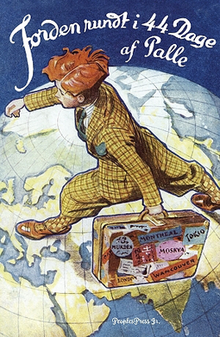
Georges Prosper Remi, known by the pen name Hergé, from the French pronunciation of his reversed initials RG, was a Belgian comic strip artist. He is best known for creating The Adventures of Tintin, the series of comic albums which are considered one of the most popular European comics of the 20th century. He was also responsible for two other well-known series, Quick & Flupke (1930–1940) and The Adventures of Jo, Zette and Jocko (1936–1957). His works were executed in his distinctive ligne claire drawing style.
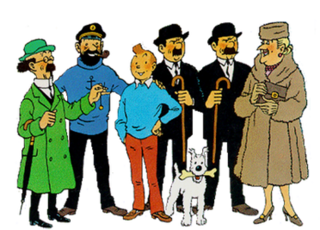
The Adventures of Tintin is a series of 24 comic albums created by Belgian cartoonist Georges Remi, who wrote under the pen name Hergé. The series was one of the most popular European comics of the 20th century. By 2007, a century after Hergé's birth in 1907, Tintin had been published in more than 70 languages with sales of more than 200 million copies, and had been adapted for radio, television, theatre, and film.

Around the World in Eighty Days is an adventure novel by the French writer Jules Verne, first published in French in 1872. In the story, Phileas Fogg of London and his newly employed French valet Passepartout attempt to circumnavigate the world in 80 days on a wager of £20,000 set by his friends at the Reform Club. It is one of Verne's most acclaimed works.
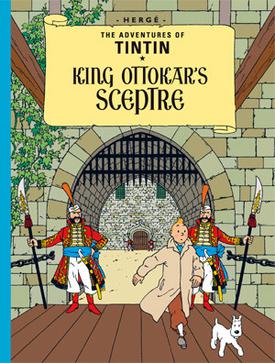
King Ottokar's Sceptre is the eighth volume of The Adventures of Tintin, the comics series by Belgian cartoonist Hergé. Commissioned by the conservative Belgian newspaper Le Vingtième Siècle for its children's supplement Le Petit Vingtième, it was serialised weekly from August 1938 to August 1939. Hergé intended the story as a satirical criticism of the expansionist policies of Nazi Germany, in particular the annexation of Austria in March 1938. The story tells of young Belgian reporter Tintin and his dog Snowy, who travel to the fictional Balkan nation of Syldavia, where they combat a plot to overthrow the monarchy of King Muskar XII.
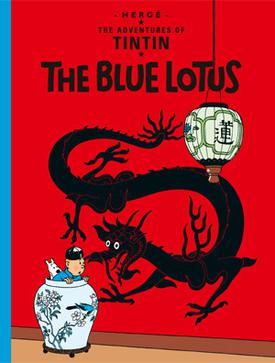
The Blue Lotus is the fifth volume of The Adventures of Tintin, the comics series by Belgian cartoonist Hergé. Commissioned by the conservative Belgian newspaper Le Vingtième Siècle for its children's supplement Le Petit Vingtième, it was serialised weekly from August 1934 to October 1935 before being published in a collected volume by Casterman in 1936. Continuing where the plot of the previous story, Cigars of the Pharaoh, left off, the story tells of young Belgian reporter Tintin and his dog Snowy, who are invited to China in the midst of the 1931 Japanese invasion, where he reveals the machinations of Japanese spies and uncovers a drug-smuggling ring.

The Shooting Star is the tenth volume of The Adventures of Tintin, the comics series by Belgian cartoonist Hergé. The story was serialised daily in Le Soir, Belgium's leading francophone newspaper, from October 1941 to May 1942 amidst the German occupation of Belgium during World War II. The story tells of young Belgian reporter Tintin, who travels with his dog Snowy and friend Captain Haddock aboard a scientific expedition to the Arctic Ocean on an international race to find a meteorite that has fallen to the Earth.

Tintin in Tibet is the twentieth volume of The Adventures of Tintin, the comics series by Belgian cartoonist Hergé. It was serialised weekly from September 1958 to November 1959 in Tintin magazine and published as a book in 1960. Hergé considered it his favourite Tintin adventure and an emotional effort, as he created it while suffering from traumatic nightmares and a personal conflict while deciding to leave his wife of three decades for a younger woman. The story tells of the young reporter Tintin in search of his friend Chang Chong-Chen, who the authorities claim has died in a plane crash in the Himalayas. Convinced that Chang has survived and accompanied only by Snowy, Captain Haddock and the Sherpa guide Tharkey, Tintin crosses the Himalayas to the plateau of Tibet, along the way encountering the mysterious Yeti.

Tintin in the Land of the Soviets is the first volume of The Adventures of Tintin, the comics series by Belgian cartoonist Hergé. Commissioned by the conservative Belgian newspaper Le Vingtième Siècle as anti-communist satire for its children's supplement Le Petit Vingtième, it was serialised weekly from January 1929 to May 1930 before being published in a collected volume by Éditions du Petit Vingtième in 1930. The story tells of young Belgian reporter Tintin and his dog Snowy, who are sent to the Soviet Union to report on Stalin's government. Knowing of his intentions, however, the secret police of the OGPU are sent to hunt him down.

Tintin in the Congo is the second volume of The Adventures of Tintin, the comics series by Belgian comic strip artist Hergé. Commissioned by the conservative Belgian newspaper Le Vingtième Siècle for its children's supplement Le Petit Vingtième, it was serialised weekly from May 1930 to June 1931 before being published in a collected volume by Éditions de Petit Vingtième in 1931. The story tells of young Belgian reporter Tintin and his dog Snowy, who are sent to the Belgian Congo to report on events in the country. Amid various encounters with the native Congolese people and wild animals, Tintin unearths a criminal diamond smuggling operation run by the American gangster Al Capone.

The Secret of the Unicorn is the eleventh volume of The Adventures of Tintin, the comics series by Belgian cartoonist Hergé. The story was serialised daily in Le Soir, Belgium's leading francophone newspaper, from June 1942 to January 1943 amidst the Nazi German occupation of Belgium during World War II. The story revolves around young reporter Tintin, his dog Snowy, and his friend Captain Haddock, who discover a riddle left by Haddock's ancestor, the 17th century Sir Francis Haddock, which could lead them to the hidden treasure of the pirate Red Rackham. To unravel the riddle, Tintin and Haddock must obtain three identical models of Sir Francis's ship, the Unicorn, but they discover that criminals are also after these model ships and are willing to kill in order to obtain them.

Red Rackham's Treasure is the twelfth volume of The Adventures of Tintin, the comics series by Belgian cartoonist Hergé. The story was serialised daily in Le Soir, Belgium's leading francophone newspaper, from February to September 1943 amidst the German occupation of Belgium during World War II. Completing an arc begun in The Secret of the Unicorn, the story tells of young reporter Tintin and his friend Captain Haddock as they launch an expedition to the Caribbean to locate the treasure of the pirate Red Rackham.
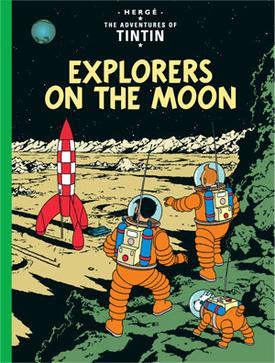
Explorers on the Moon is the seventeenth volume of The Adventures of Tintin, the comics series by Belgian cartoonist Hergé. The story was serialised weekly in Belgium's Tintin magazine from October 1952 to December 1953 before being published in a collected volume by Casterman in 1954. Completing a story arc begun in the preceding volume, Destination Moon (1953), the narrative tells of the young reporter Tintin, his dog Snowy, and friends Captain Haddock, Professor Calculus, and Thomson and Thompson who are aboard humanity's first crewed rocket mission to the Moon.
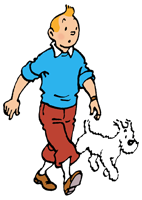
Tintin is the titular protagonist of The Adventures of Tintin, the comic series by Belgian cartoonist Hergé. The character was created in 1929 and introduced in Le Petit Vingtième, a weekly youth supplement to the Belgian newspaper Le Vingtième Siècle. Appearing as a young man with a round face and quiff hairstyle, Tintin is depicted as a precocious, multitalented reporter who travels the world with his dog Snowy.
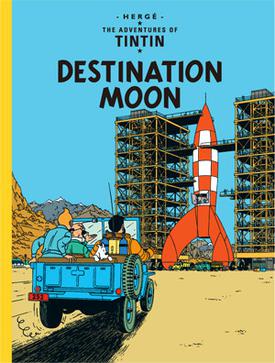
Destination Moon is the sixteenth volume of The Adventures of Tintin, the comics series by Belgian cartoonist Hergé. The story was initially serialised weekly in Belgium's Tintin magazine from March to September 1950 and April to October 1952 before being published in a collected volume by Casterman in 1953. The plot tells of young reporter Tintin and his friend Captain Haddock who receive an invitation from Professor Calculus to come to Syldavia, where Calculus is working on a top-secret project in a secure government facility to plan a crewed mission to the Moon.

Popol Out West is a comic by the Belgian cartoonist Hergé, better known as the creator of The Adventures of Tintin series. Commissioned by the conservative Belgian newspaper Le Vingtième Siècle for its children's supplement Le Petit Vingtième, it was serialised weekly from February to August 1934. The story tells of two anthropomorphic bears, Popol and Virginia, who travel into the Wild West to sell hats, facing opposition from a tribe of hostile Native American rabbits and a criminal bulldog named Bully Bull.

Le Petit Vingtième was the weekly youth supplement to the Belgian newspaper Le Vingtième Siècle from 1928 to 1940. The comics series The Adventures of Tintin first appeared in its pages.

The Adventures of Totor, Chief Scout of the Cockchafers is the first comic strip series by the Belgian cartoonist and author Hergé, who later came to notability as the author of The Adventures of Tintin series. It was serialised monthly from July 1926 to summer 1929 in Belgian scouting magazine Le Boy Scout Belge, with a nine month break in 1927. The plot synopsis revolved around the eponymous Totor, a Belgian boy scout who travels to visit his aunt and uncle in Texas, United States. Once there, he comes across hostile Native American tribes and gangsters, each of whom he outwits, before returning to Belgium.

The Unicorn is a fictional 17th-century three-masted armed French Royal Navy vessel appearing in The Adventures of Tintin, the comics series by Belgian cartoonist Hergé. The ship plays a leading role in both The Secret of the Unicorn and Red Rackham's Treasure, published in 1943 and 1944, respectively. The Unicorn also appears in the 2011 film adaptation The Adventures of Tintin: The Secret of the Unicorn.
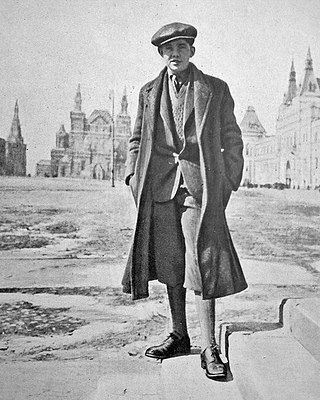
Palle Huld was a Danish Boy Scout film actor and writer. He appeared in 40 films between 1933 and 2000. He was born in Hellerup in Denmark. His journey around the world at the age of 15 in 1928 reportedly inspired Hergé to create Tintin.
Michael Farr is a British expert on the comic series The Adventures of Tintin and its creator, Hergé. He has written several books on the subject as well as translating several others into English. A former reporter, he has also written about other subjects.
